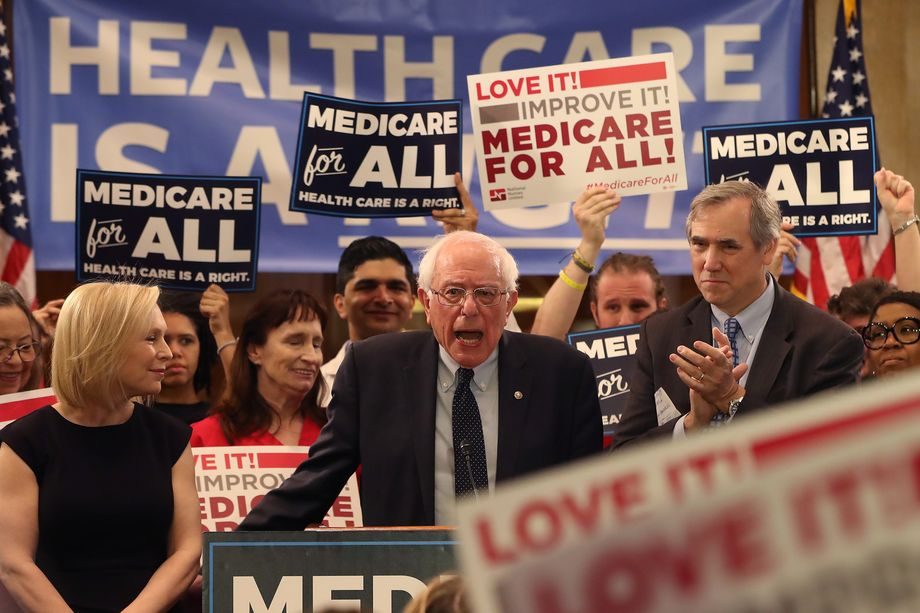
KONNOR VON EMSTER – JANUARY 5TH, 2020 EDITOR: ODYSSEUS PYRINIS
“Health Care as a Human Right” are the precious words that are emblazoned across Bernie Sanders’ website, expressing his intent to cover all Americans under his “Medicare for All” plan. His campaign website, abound in emotional appeals, states his primary goal of “joining every other major country on Earth and guaranteeing healthcare to all people.”
Bernie Sanders supporters, defending their proposition to implement “Medicare for All,” frequently cite the fact that over 30 million Americans are uninsured and many more are underinsured. The US spends almost double what most developed countries spend on healthcare, yet the American people still suffer from “worse health outcomes and a higher infant mortality rate.” Considering that the primary cause of bankruptcy is medical debt, people’s stress over health-related issues is often not about the care they are receiving, but how they are able to pay for it.
While Democratic candidates have historically tried to tackle this monstrous issue, former party leaders were unsuccessful in their attempts to overhaul the healthcare system, which is why it has become a hot button issue in the Democratic primaries. Candidates are either scrambling to develop their plans or choosing whom to back. Elizabeth Warren recently released her single-payer plan with financing details (details in this BER article). On the other hand, Bernie Sanders has been less focused on financing and more focused on promising benefits that his plan will provide.
Here is all there is to currently know about Sanders’ plan and some economic analysis outlining its feasibility.
The Four Promises
The “Medicare for All” plan has taken on several different forms in recent times. Not only have there been multiple congressional bills proposed by Sanders, but there is now a proposed funding plan and a broad program outline available on his website. His most recent promises, outlined on his website, are stated below.
The first is obvious: Medicare, for all. This means nationalized healthcare coverage for all Americans without differentiating based on wealth, income, age, or affiliations. This essentially copies the beveridge healthcare model followed by many European nations where the government provides free healthcare to the entire nation. However, a glaring concern is the massive cost associated with implementing this federal program, especially since the US does not have marginal tax rates as high as many European countries with such provisions. While estimates vary widely on the cost of such a bill, it will be somewhere in the ballpark of the current cost of private healthcare, valued at $3.6 trillion per year, or about 17.7% of GDP. Were this to be assumed onto the public balance sheet at an even rate, it would suddenly increase the current federal expenditure of $4.746 trillion per year by 75%.
The second promise reflects the goal of nationalized healthcare: no cost-sharing. While this is a contentious issue, Sanders seeks to eliminate cost-sharing so that healthcare is affordable to all Americans. Many countries do offer some form of cost-sharing often in the form of prescription deductibles, specialty visit co-pays, or in-patient services.
The third promise states the laundry list of items to which his plan extends coverage. An excerpt includes: “dental, hearing, vision, and home and community-based long-term care, in-patient and out-patient services, mental health and substance abuse treatment, reproductive and maternity care, and prescription drugs.” This is a huge expansion from current Medicare coverage and seeks to capture voters who require financial assistance for these crucial services. At the same time, this will absorb even more private industries onto the public balance sheet and significantly increase the cost of such a bill over the current Medicare spending paradigm.
The final promise is to implement an annual per capita cost cap of $200 for pharmaceutical expenditures. To accomplish this, Sanders proposes that Medicare negotiate with pharmaceutical companies to lower prescription drug prices. Another proposal includes buying drugs across national borders from Canada, where drugs are cheaper. The latter proposition would restore some of the free market associated with drug pricing. In a proposal similar to Warren, Sanders desires to peg the price of drugs to the median price of five major developed countries: Canada, the United Kingdom, France, Germany, and Japan.
Additionally, Sanders submitted the Medicare for All Act of 2019 in the Senate on April 10, 2019, where it was referred to the Committee on Finance. This bill gives a much more exact plan of what Sanders’ “Medicare for All” proposal may entail. The bill would allow patients to choose their doctors, although it would also allow doctors to decide whether to practice inside or outside the Medicare system. Overall the structure is very similar to current Medicare standards with some slight changes. Cost containment would come in the form of a fee schedule similar to Medicare’s current assessment and capital improvements would receive their own allowance. The transition will involve eligibility requirements decreasing over time until the entire population is covered.
Financing
Unlike fellow Democratic primary frontrunner Elizabeth Warren, Bernie Sanders has not released his entire financing plan. He instead claims that the financing can be settled later and that the healthcare provision is the most important part. However, when introducing his bill into the Senate last April, he did include a financing plan that would likely be similar to what would be proposed in the future.
This plan comes in six main parts: employer tax, income tax increases, capital gains change, wealth tax, elimination of tax breaks, and offshore corporate tax. While six parts may sound numerous, for perspective, Warren’s financing plan, excluding cutting costs in healthcare, has over ten components.
Sanders’ proposed employer tax is different from what Warren has proposed. Warren suggests transferring the medical insurance expenditures of companies into an equal Medicare contribution, whereas Bernie has proposed nixing medical insurance expenditures in favor of a 7.5% income based premium to be paid by employers. This would actually be a cost saving measure for the average business as Sanders estimates this will save $9,000 per employee. To combat difficulties for small businesses, the first $2 million in income taxes would be exempt.
A contentious point for many people is the increase in income taxes. Warren avoided this issue by promising to not increase taxes for the middle class, which then required many other new and bizarre tax proposals to make up the difference. Sanders has opposed this in favor of a 4% increase in income taxes for all, after which his experts claim the typical middle class family would save on average over $4,400 per year under this plan. While tax increases cause a decrease in disposable income, for middle class families the difference is made up by no longer needing to pay for expensive insurance plans or high deductibles. The average middle class family that pays $5,277 for an insurance plan would instead see their taxes increase by only $844. This is because many of the administrative insurance costs of healthcare would be eliminated in a single-payer program.The entire medical insurance industry, which in general helps through income smoothing and disaster protection, would no longer be necessary as healthcare would be provisioned to everyone.
While most people’s costs would decrease according to Sanders’ estimates, he does not account as readily for the elimination of tax breaks that were previously used to subsidize healthcare expenses. Presumably, Americans would no longer require these tax breaks since all of their healthcare would be covered under this plan.
Additionally, Sanders has been at the forefront of proposing a more progressive, socialist style marginal income tax scheme. This would mean increasing many of the marginal rates for America’s top earners, even hitting 50% above $2 million in income. To supplement this he is also looking to lump in realized capital gains into income taxation and has solicited one of America’s wealthiest men, Warren Buffet, in agreement. Currently, capital gains is taxed much lower than income so those with vast stock options are able to pay a lower marginal tax rate under the pretense of risk assumption. This will effectively challenge income inequality more effectively as well as provide needed revenue for “Medicare for All.”
While increasing income taxes will undoubtedly provide substantial revenue, Sanders also hopes to tap into a hitherto unrealized resource: America’s extreme wealth. Sanders proposes a 1% tax on the wealthiest 1%, which is a far cry from Warren’s proposal of 2% on wealth over $50 Million and 6% on wealth over $1 Billion. The result will be a slight erosion in wealth inequality while minimizing the possible disastrous consequences of a large wealth drain from the US.
The last stage of his proposal deals with the astronomical amounts of money US corporations store in tax havens. This would force companies to pay taxes on this wealth in a one time installment, although Sanders does not have a clear proposal for what tax rate or time frame on which this would occur. Obama proposed a similar plan of allowing companies to repatriate their wealth at a 14% rate, far less than the 35% corporate tax rate at the time.
Discussion
The Congressional Budget Office (CBO) commented on the single-payer healthcare plan in May, 2019, although it offered more questions than answers. Unlike previous budget proposals that include detailed facts, figures, and hard line estimates of spending, the CBO was much more qualitative than normal in this assessment. The issue is that single-payer plans can take an immense number of forms and the ability to estimate all of its far reaching effects is very difficult. While it may be easy to say that all healthcare costs are assumed onto the public balance sheet, there is uncertainty over the future cost of healthcare provision, in part through elimination of the health insurance industry and healthcare specific inflation. While the government would have more bargaining power against pharmaceuticals, Big Pharma will undoubtedly resist large changes.
Without many specifics of the plan, the CBO cannot come up with as concerte of an estimate, which could be a reason Sanders is slow to make financial promises. He has not detailed how much the government system would pay out to providers, unlike Warren’s extensive plan that covers many healthcare cost saving initiatives. There could be issues of doctor shortages or rationing of healthcare, complications that other countries who have transitioned to universal health care have dealt with using queuing or gatekeeping.
The New York Times summed up “Medicare for All” as what “would amount to the largest domestic policy change in decades,” and it is easy to see why. Not only would an entire industry be enveloped (see consequences in the discussion of Warren’s single-payer system here), but numerous other industries would also be affected by Sanders’ extensive plan, which is setting itself to be one of the most ambitious plans in existence. His healthcare implementation includes several services that other countries do not provide for free to all of their citizens. For example, vision, dental, and pharmaceutical co-payments are only provided free of charge to low income families in even the most generous countries such as the UK and France. With a promise of no-copayment, Sanders will require even more funding than some of the most extensive universal healthcare systems in the world.
The Physicians for a National Health Plan (PNHP) also analysed the bill and outlined several places the bill can be improved. The PNHP opposed the separation of capital improvements and hospital services as they presumably go hand in hand to maximize patient care. Additionally, the Medicare payment scheme, while vast and well established, can give hospitals some perverse incentives in patient care and also fail to reduce costs. While Sanders’ bill is extensive, it does not cover one glaring issue: long term institutional care, such as a mental health ward. PNHP also encourages the abolishment of for-profit health facilities, citing lower care standards and higher costs than standard non-profit care centers.
What is most concerning for many Health Economists is the lack of rationing for high-cost, ineffective treatments, specifically in health technology assessments (HTAs). Many advanced, developed countries with universal healthcare have independent medical boards that determine which treatments are cost-effective using HTAs. These have also been disparagingly called death panels as they put a maximum dollar value on treatment for each life year gained. While grim, these panels are able to curb significant cost inflation and prevent extremely expensive treatments from being free for all to use, thus increasing moral hazard. In the case a treatment is determined to exceed the cost effective threshold, the patient would then need to choose whether or not to pay for it.
As it currently stands, the US has no HTA board as its previous one, the Independent Payment Advisory Board (IPAB), was repealed, dumping one of the key components to keep the Affordable Care Act’s cost minimized. Medicare does not have any sort of cost-effectiveness analysis or HTA, which has lead to rising premiums and deductibles as medical treatments are not bounded in cost. The law states that if it is deemed an effective treatment by the FDA, Medicare is liable to pay for it, even if said treatment has low effectiveness, costs hundreds of thousands of dollars, and only increases life expectancy by months. One can imagine how this can easily get out of hand, which is why many countries, including Canada, UK, Australia, Russia, and Mexico, all have HTAs attached to their universal healthcare plans.
One other concern that some health economists have expressed is toward the elimination of cost-sharing. While cost-sharing that is too high can certainly hurt low income families, at zero cost-sharing, the system will need to rely much more heavily on other healthcare rationing measures such as queuing and gatekeeping, which will breed resentment in long wait times for simple procedures. There would also be an increase in moral hazard as people are price sensitive to health goods, although considering that many people already skimp on required services because of their costs, implementing a national single-payer service could bring the quantity closer to the social optimum. The only risk is that the elimination of cost-sharing will drive the demand past what is socially optimal.
Overall, Sanders has made a lot of promises that are likely to be challenged very early on in his presidency. Without firm details on finances or health services, his promises are unconvincing. Only until they are grounded in sturdy plans will they have a chance at execution. As the CBO and Physicians for a National Health Program agree, this proposal requires many more details not currently available. Whether or not voters will care about the plan’s level of development is up for debate as Bernie Sanders has recently been rising in the polls against his primary single-payer opponent, Elizabeth Warren. Whether that is due to Warren’s healthcare plan or an ulterior reason cannot be confirmed. At the end of the day it seems that voters will decide and, as found in this AP poll, the information they receive will largely determine who they support. Come this summer, the Democratic presidential candidate will be chosen, and healthcare provision will undoubtedly play a large role in the 2020 election cycle.
Featured Image Source: Vox
Disclaimer: The views published in this journal are those of the individual authors or speakers and do not necessarily reflect the position or policy of Berkeley Economic Review staff, the Undergraduate Economics Association, the UC Berkeley Economics Department and faculty, or the University of California, Berkeley in general.




One thought on “Bernie Sanders’ Moral Crusade to Implement Medicare for All”